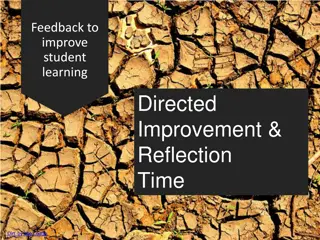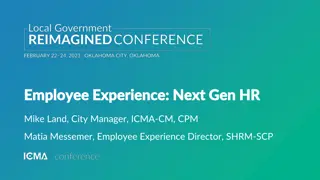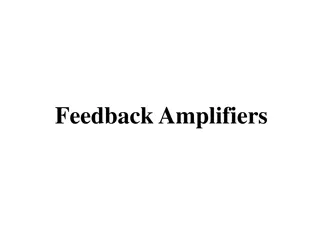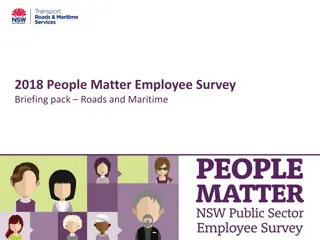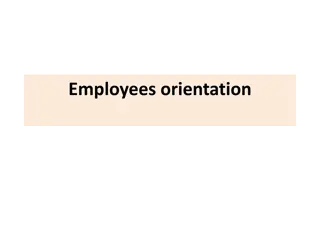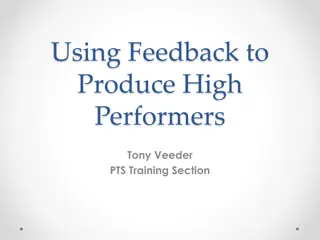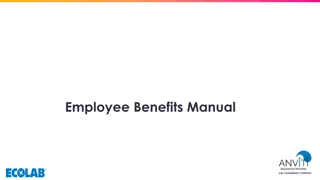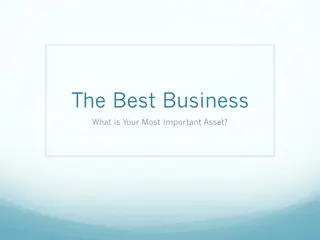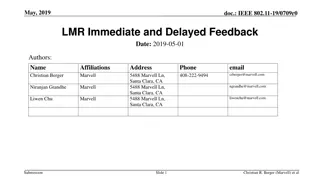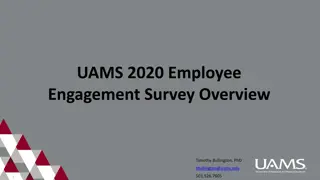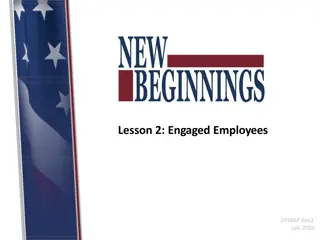
Effective Employee Experience Feedback Collection
Learn a simple approach for collecting employee experience feedback to evaluate adoption and satisfaction levels, fostering a positive workplace culture. Discover tips on methods, data analysis, and more to enhance employee-centric environments.
Uploaded on | 1 Views
Download Presentation

Please find below an Image/Link to download the presentation.
The content on the website is provided AS IS for your information and personal use only. It may not be sold, licensed, or shared on other websites without obtaining consent from the author. If you encounter any issues during the download, it is possible that the publisher has removed the file from their server.
You are allowed to download the files provided on this website for personal or commercial use, subject to the condition that they are used lawfully. All files are the property of their respective owners.
The content on the website is provided AS IS for your information and personal use only. It may not be sold, licensed, or shared on other websites without obtaining consent from the author.
E N D
Presentation Transcript
Guide to collecting employee experience feedback To evaluate employee adoption and To evaluate employee adoption and satisfaction satisfaction Date: May 2024 Image result for canada wordmark
* The French version of this document is available here : FR version About this Guide About this Guide This Guide proposes a simple and effective approach for gathering employee experience feedback that will complement the data you gathered throughout your project via the CM Monitoring Questionnaire and the CM Activity Journal. Gathering employee experience feedback provides insights into how employees have adopted the change, and their levels of competence and satisfaction with the change. It also helps to understand employee morale, preferences, and challenges. Continuous feedback collection contributes to a supportive and employee-centric environment, fostering a positive workplace culture. A Data collection question bank, proposing question examples on workplace experience and change adoption, is available for use as a starting point for any of the proposed feedback methods. T Text highlighted in yellow in yellow must be personalized. ext highlighted We recommend that you collaborate with your organization s data experts to seek expertise and to ensure you are following proper protocol for data gathering. Image result for canada wordmark 2
Contents Contents 1. Recommended Approach 2. Communicating and engaging with employees 3. Feedback methods Quick Poll Questionnaire Informal group discussions Informal 1:1 dialogue Observation 4. Data consolidation and analysis Image result for canada wordmark 3
1. Recommended approach (1 of 3) 1. Recommended approach (1 of 3) Analyzing workplace satisfaction and adoption data involves a combination of quantitative and qualitative methods gain a comprehensive understanding of employee experiences and the effectiveness of the workplace. Gathering both quantitative and qualitative data is crucial because they present a holistic view of the situation, allow mutual validation of findings and improve decision-making. combination of quantitative and qualitative methods to Qualitative data Quantitative data Quantitative data is information that can be quantified, meaning it can be counted or measured and given a numerical value. This type of data is structured and suitable for statistical analysis. We recommend defining your objectives and metrics by setting clear goals for what you want to measure, such as engagement levels, satisfaction rates, or specific aspects of the workplace environment. If your organization is gathering occupancy data, it would be a good complement to your other quantitative methods to understand how the space is being used. Qualitative data is non-numerical information that captures the qualities and essence of a subject. It is descriptive and often collected through interviews, focus groups, observations, and case studies. This data helps understand concepts, opinions, or experiences and can be presented as text, audio, or visuals. It is valuable for research requiring detailed examination and interpretation. Image result for canada wordmark 4
1. Recommended Approach (2 of 3) 1. Recommended Approach (2 of 3) Use this approach with its variety of feedback gathering methods to collect valuable insights on the employee experience. Refer to Annex D for examples that demonstrate how to consolidate data and analyze the results to draw conclusions. Administer a poll or questionnaire questionnaire to all impacted employees Integrate occupancy data if available poll or Observe workplace utilisation behaviours and confirm questionnaire/ discussion findings using Observation Observation Gather direct feedback and supplement questionnaire findings using a combination of Informal Group Discussions Informal Group Discussions and Informal 1:1 Dialogue Informal 1:1 Dialogue Qualitative data Quantitative data Image result for canada wordmark 5
1. Recommended approach (3 of 3) 1. Recommended approach (3 of 3) Below is a proposed schedule to help you plan to capture all employee feedback post-occupancy Prepare to gather all feedback 2-4 weeks before opening day. Use the Pre experience feedback from the first moments employee's start using the new workplace. Pre- -opening checklist opening checklist to ensure you are ready to gather employee 1 4-week post-occupancy 1-4 months months post-occupancy 6+ months months post-occupancy Administer a survey to all impacted employees Create a data gathering report using all the feedback and data you have gathered Gather and consolidate all employee experience feedback Analyze survey results and supplement findings with Informal group discussions, Informal 1:1 dialogue and Observation Continuous improvement cycle Consider how you can ask Quick poll questions to gather initial feedback Present the data gathered to your organization as part of your change management final report Image result for canada wordmark 6
2. Communicating and engaging with employees 2. Communicating and engaging with employees To encourage employees to take part in data collection, it s important to communicate the benefits clearly. Let them know how the data will help improve the workplace and their own work experience. Senior leaders should also participate and show their support. The process should be made as simple as possible and reassure employees that their privacy will be protected. Additionally, sharing the outcomes of the data collection can demonstrate the value of their input. Giving employees a say in how the data is used can also make them feel more involved and invested in the process. These steps can help build a workplace culture that appreciates the importance of data and encourages everyone to play a part in its collection. You can use the following key messages key messages to motivate employees to participate to the various data collection methods. Participating in the questionnaire allows you to voice your opinions and contribute to the continuous improvement of the workplace employee experience. Your individual input, as collective feedback helps identify patterns and areas for enhancement that benefit everyone. By completing the questionnaire, you will help our Accommodations and IT teams to find solutions to address specific issues. By providing feedback, you will contribute to reach the goal of creating a healthier and more positive workplace for you and your colleagues. The questionnaire is a proactive measure to understanding and enhancing your satisfaction with our new workplace. Image result for canada wordmark 7
3. Feedback methods 3. Feedback methods Gathering feedback is crucial for understanding user experiences, getting a full picture of the situation in the workplace, and making informed decisions when required. Effective feedback data gathering methods help organizations collect both quantitative and qualitative information, providing a well-rounded view of performance and satisfaction. These methods enable the identification of strengths and areas for improvement, ensuring that decisions are based on comprehensive and actionable insights. Quantitative data Qualitative data Quick Poll Informal group discussions Questionnaire Informal 1:1 dialogue Observation Image result for canada wordmark
Quantitative data Quick Poll Quick Poll In the first weeks post-occupancy, it s important to capture employees' feedback on their experience using the new workplace. Here are some questions you can ask via your Change Agent Network, Workplace Coordinators, a QR code posted on site, a suggestion box, etc. The Data collection question bank also proposes question examples who can used or customized to gather the data. Examples of Questions for quick polls: Which [organization name] workspace did you use today?* - [locations] How would you rate your overall experience in the workplace today? - from 1 (poor) to 5 (fantastic) What did you find most helpful during your time on site? - The Workplace coordinator(s) - The QR codes/digital posters for etiquette and how-tos - The way the workplace is set-up and its amenities - The technology available What could have made your experience better? *Optional question use if you have more than one floor and/or if you d like to identify areas separately. Image result for canada wordmark 9
Quantitative data Questionnaire Questionnaire WHY A quick anonymous way to get feedback from a large number of employees WHO All impacted employees HOW You can use the questions provided in the Data collection question bank document to develop and setup a questionnaire using your preferred survey platform Send a link sent via email/newsletter and post on your intranet Display a QR code in the workplace for easy access to the questionnaire Use your various networks to remind employees to respond (managers, change agents, etc.) Include WIIFM key messages in your communications to incentivise employees to respond When communicating with employees, ensure to set expectations on how their feedback will be used and if any changes to the workplace can be expected Image result for canada wordmark 10
Qualitative data Informal Group Discussions (1 of 2) Informal Group Discussions (1 of 2) WHY WHO HOW Informally gather insights in groups where participants react together and build off each other s comments Representative* groups of 5-12 impacted employees. You may curate the audience based on topics Select a strong facilitator to lead the discussions Following review and analysis of the questionnaire results, identify areas where you would like to gather additional insights and let those guide your informal group discussions Use the Informal group discussion framework as a starting point to organize your sessions *To draw valid conclusions from your results, carefully decide how you will select individuals/groups that are representative of all impacted employees. Whether a random selection of impacted employees or individuals/groups based on specific criteria (ex. managers, Young Professionals, etc.), it will be important to explain how they were selected. Image result for canada wordmark 11
Qualitative data Informal Group Discussions (2 of 2) Informal Group Discussions (2 of 2) When preparing your group sessions, consider the amount on content to cover and number of employees invited and ensure to reserve enough time. Group sessions should have a strong facilitator that can create a safe sharing space, guide discussions, encourage active participate and manage time effectively. 1. 1. Introduction and Ice Introduction and Ice- -breaker Welcome and set the context for the group discussions Outline the objectives: assessing change management effectiveness, gauging employee experience, and identifying areas for improvement Emphasize the importance of open and honest communication Ice-breaker: Encourage participants to share a positive aspect of their experience post-transformation breaker 3. 3. Sharing Experiences Sharing Experiences Facilitate a discussion where participants can build on each other's comments Encourage sharing of both positive and difficult experiences 4. 4. Identifying Areas for Improvement Identifying Areas for Improvement Facilitate a discussion on areas where participants believe improvements can be made Ask for suggestions on enhancing the employee experience and addressing any lingering challenges 2. 2. Questions and Assessment Questions and Assessment Ask specific questions that require follow-up from the Workplace Employee Experience Questionnaire Encourage participants to provide specific examples and insights 5. 5. Wrap Wrap- -up up Summarize key points discussed Discuss next steps, such as how insights will be used and the timeline for implementing improvements Thank participants for their valuable input Image result for canada wordmark 12
Qualitative data Informal 1:1 Dialogue (1 of 2) Informal 1:1 Dialogue (1 of 2) WHY WHO HOW Gather individual, in-depth informal feedback in a private setting A representative* selection of impacted employees Ensure a climate of safety, trust and transparency for employees to be comfortable in sharing Select a strong facilitator to lead the discussions Following review and analysis of the questionnaire results, identify areas where you would like to gather additional insights and let those guide your informal 1:1 dialogue Use the Informal 1:1 Dialogue framework as a starting point to organize your interviews *To draw valid conclusions from your results, carefully decide how you will select individuals/groups that are representative of all impacted employees. Whether a random selection of impacted employees or individuals/groups based on specific criteria (ex. managers, Young Professionals, etc.), it will be important to explain how they were selected. Image result for canada wordmark 13
Qualitative data Informal 1:1 Dialogue (2 of 2) Informal 1:1 Dialogue (2 of 2) When preparing your 1:1 dialogues, consider the setting where you will host the interviews (whether in person or virtual) to ensure participants are at ease. 1:1 dialogues should have a strong facilitator that can create a safe sharing space, guide discussions, encourage active participate and manage time effectively. 1. 1. Introduction and Establishing Trust Introduction and Establishing Trust Welcome and express appreciation for the employee's time Emphasize the importance of their honest feedback Build rapport by asking about their well-being and ensuring they feel comfortable. Clarify the confidential nature of the conversation and reassure them that their input is valuable Share the purpose of the dialogue: to understand their unique perspective and experiences 3. 3. Opportunities for Feedback Opportunities for Feedback Provide space for the employee to express any concerns or reservations openly Ask about specific areas where they might need additional support or resources Explore whether there are aspects of the transformation that were particularly challenging for them 4. 4. Wrap Wrap- -up up Summarize key points discussed during the dialogue Express gratitude for their openness and valuable insights Assure them that their feedback will contribute to positive changes 2. 2. Questions and Assessment Questions and Assessment Begin with general questions to ease into the conversation. For example: "How would you describe your overall experience with the recent workplace modernization?" Ask specific questions that require follow-up from the Workplace Employee Experience Questionnaire Encourage participants to share personal anecdotes that highlight their journey Image result for canada wordmark 14
Qualitative data Observation (1 of 3) Observation (1 of 3) WHY Confirm and validate findings from the questionnaire, the informal group discussions and the informal 1:1 dialogue by capturing concrete behaviours that support the subjective feelings expressed by employees WHO Consider involving your Change Agent Nnetwork to foster engagement and trust with employees HOW Inform employees of this approach. By raising awareness and communicating, there is less opportunities for them to feel like they are being monitored. Make sure they know that you are observing behaviours to ensure their experience is the best it can be and you get the results you need. Determine which results and comments you would like to confirm and create an observation plan and schedule using the Observation framework and table template Image result for canada wordmark 15
Qualitative data Observation (2 of 3) Observation (2 of 3) When conducting a workplace observation study, consider defining clear objectives, selecting relevant behaviors to observe, ensuring observer reliability (we recommend using your Change Agent Network), maintaining confidentiality, and analyzing data systematically to draw meaningful insights. Additionally, establish a standardized observation protocol using the Observation table template as a starting point and schedule observations at representative times. 1. 1. Pre Pre- -observation and communications observation and communications Brief observers on the objectives of the observation and the key focus areas. Emphasize the importance of being unobtrusive to capturing natural behaviour Announce to employees that there will be observers present to gather insights on their experience in the workplace Ensure employees know that the observation is not evaluative but rather aimed at improving the overall workplace employee experience 3. 3. Documenting Documenting Ask observers to compile detailed notes on their observations, highlighting both positive aspects and areas for improvement Document any unexpected behaviors or patterns that may not have surfaced in surveys or interviews 4. 4. Validation session Validation session Convene with your colleagues, and if required with employees from the informal group discussions and informal 1:1 dialogue, to discuss and validate your observations Cross-reference findings with questionnaire results, informal group discussions , and informal 1:1 dialogue to identify common themes Prioritize insights that align with the overall objectives of the workplace modernization 2. 2. Observation period Observation period Discreetly observe employees in their natural work environment (ex: workpoints used, occupancy of rooms, respect of etiquette, most used workpoints, etc.) Take notes on any noteworthy behaviors, interactions, or challenges observed Image result for canada wordmark 16
Qualitative data Observation (3 of 3) Observation (3 of 3) You can use this table as a starting point to gather your observation data. It can also be beneficial to use a floor plan to pinpoint the exact location of the observations. Remember to adapt the table to your specific needs, adding or modifying columns as required for your observation study. Observation table Observation table Name of observer: Name of observer: Date and time Location Observed action/behaviour Duration Notes/comments 1. 2. 3. 4. 5. Date and time: The date and time when the observation took place. Location: The specific place or department where the observation occurred. Observed action/behavior: A description of the action or behavior under observation. Duration: The time taken for the observed action or behavior. Notes/comments: Any additional comments or observations that provide context or insights. Image result for canada wordmark 17
4. Data consolidation and analysis 4. Data consolidation and analysis Remember, the key to effective analysis is to integrate both quantitative and qualitative insights to form a holistic view of workplace satisfaction and adoption. This approach allows you to not only identify areas that need attention but also to understand the underlying reasons behind the data, enabling you to make more strategic and impactful improvements. Qualitative data Quantitative data Using your define objectives and metrics such as engagement levels, satisfaction rates, or specific aspects of the workplace environment, look for trends, averages, and correlations in the data. You can compare your results against industry standards or previous surveys to gauge progress and identify areas for improvement. Review the qualitative data to identify common themes or issues that emerge from the discussions. Cross-Reference with Quantitative Data: Look for patterns in the qualitative data that explain the quantitative results, providing a fuller picture of employee satisfaction, adoption and competency. Image result for canada wordmark 18
4. Data consolidation and analysis (2 of 2) 4. Data consolidation and analysis (2 of 2) Your data team can help you process and interpret data, format it for analysis, and create meaningful insights. They also ensure data quality and accuracy before analysis. Following data management best practices ensures your data is accurate and complete. The nature of qualitative data makes it difficult, if not impossible, for the person doing the analysis to separate themself from the data. To avoid bias, there are ways to maintain objectivity with qualitative data analysis: Use multiple people to analyse the data: If there is some consistency between your interpretation and that of others, then it is more likely that there is some truth by agreement in your interpretations. Review findings with peers: Ask others to review your conclusions. Sometimes others will see things that you missed or can identify gaps in your argument that need to be addressed. They also can provide affirmation that your conclusions are sound and reasonable given your data. Have participants review your draft report: Ask the people who provided the data whether your interpretations seem to be representative of their beliefs. In the following pages, you will find 4 examples results to draw conclusions. 4 examples that suggest how to consolidate qualitative and quantitative data and analyze the Image result for canada wordmark 19
Example 1 Example 1 Collaboration room availability Collaboration room availability Look at the room reservation system to corroborate employee statements on room availability. Conduct onsite observations to confirm if booked rooms are actually being used. Q: I have access to collaboration spaces that allow me to connect with colleagues in person and/or virtually. Data breakdown reveals Branch X have the highest percentage of employees who answered Disagree. Host an informal group discussion or 1:1 dialogue with employees from this Branch to understand the reason(s) behind their answer. Qualitative data Quantitative data Agree Employee statement: Every time I need a meeting or project room, they are all busy and I cannot find one in the booking system. Disagree Disagree Unsure/neutral Image result for canada wordmark 20
Example 2 Example 2 Workstation availability Workstation availability Look at the booking system to corroborate employee statements on workstation availability. Conduct onsite observations to confirm if workstations are actually being used. Q: I have access to a variety of workpoints that suit my work activities and preferences A high percentage of employees responded Disagree to this question. Host an informal group discussion or 1:1 dialogue with a diverse representation of employees to understand the reason(s) behind their answer. Qualitative data Quantitative data Agree Employee statement: I often have to work from a Touchdown since all the Workstations are reserved in the Booking system. This is not ideal as I require 2 monitors to be most productive. Disagree Disagree Unsure/neutral Image result for canada wordmark 21
Example 3 Example 3 Use of variety of workpoints Use of variety of workpoints Conduct daily floor walkthroughs to confirm if specific workpoints are being used or not at the frequency employees have indicated in their responses. Host an informal group discussion or 1:1 dialogue with a diverse representation of employees to understand the reason(s) why certain workpoints are not being used. Is it because of the furniture, location, noise, temperature? Do they understand the purpose and the use of the workpoints? Q: Please rate how often you use the following workpoints. Qualitative data Employee statements: The Teaming Area in the North corner is always cold. Focus pod ### is too close to the interactive zone. The air systems in the Study is too loud and makes it impossible to concentrate! We always have a team member in telework; Meeting rooms are more suited for our teamwork. Quantitative data Focus room Workstation Teaming Area Huddle Image result for canada wordmark 22
Example 4 Example 4 Team productivity Team productivity Q. What impact do you think the workplace design has on the following aspects: a) Your team's productivity b) Your personal productivity c) Your collaboration with others For the impact on Team productivity, managers responded with a higher percentage of positive, whereas employees responded with negative. Host an informal group discussion or 1:1 dialogue with managers and another with employees to understand the variance in response to this question. In this case, observation may not be required. Qualitative data Quantitative data Negative Neutral Positive Don t know Employee statement: I don t like using workstations in the interactive zone like the rest of my team, so I am often sitting by myself in the quiet zone Manager statement: The variety or workpoints to which we have access on the floors is great. In our team in-office days, I can have impromptu conversations with my team members that choose to sit in the interactive zone. Image result for canada wordmark 23

